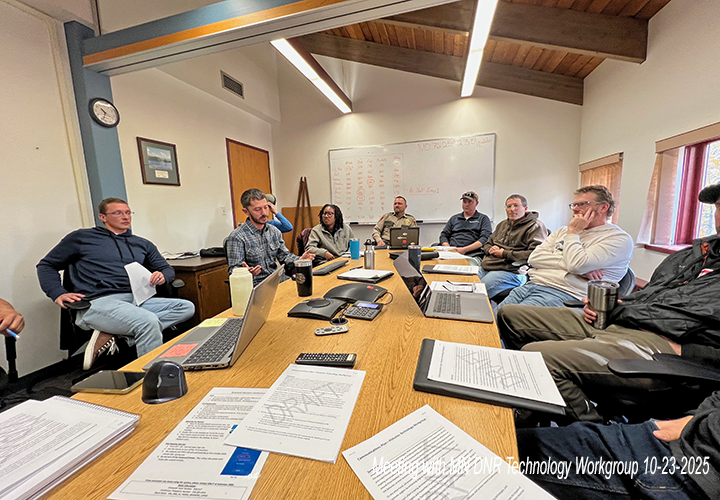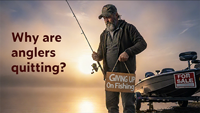
 Jeff Sundin October 2025 "Minnesota DNR Technology Workgroup"
Jeff Sundin October 2025 "Minnesota DNR Technology Workgroup"
 The Minnesota DNR’s Technology Workgroup has a big job on its hands, identifying the good, bad and indistinguishable impacts of modern technology on Minnesota fish populations. At some point, the group will offer guidance about what, if anything, can or should be done regarding the ever-expanding availability of fishing technologies. The workgroup, made up of citizens, fisheries officials, DNR Enforcement and a variety of “industry experts” has been hammering out details about “the plan” for nearly 2 years now.
The Minnesota DNR’s Technology Workgroup has a big job on its hands, identifying the good, bad and indistinguishable impacts of modern technology on Minnesota fish populations. At some point, the group will offer guidance about what, if anything, can or should be done regarding the ever-expanding availability of fishing technologies. The workgroup, made up of citizens, fisheries officials, DNR Enforcement and a variety of “industry experts” has been hammering out details about “the plan” for nearly 2 years now.
Whether the outcome will eventually lead to new regulations remains to be seen. But first, the group has been moving toward establishing a formal “communication plan”. That goal, now nearing completion, was one of the main topics of a Technology Workgroup meeting in Brainerd on Thursday. The communication plan, still in draft form, was distributed to the workgroup members, all of whom may offer any final recommendations before the plan’s final approval. Once approved, the full plan will be available here, along with several additional public outlets.
Gathering data, the mother’s milk of scientific research was next up on the agenda.
First up was a report from Cam Mosley about the establishment of a joint University of Minnesota, and LCCMR Fishing technology Project. The project, aimed at gathering facts about how technology is used, and by whom, will begin sometime early next summer. At the meeting, Mosely grilled members for ideas about study goals that will lead to gathering the most pertinent and useful information. More details about the study will be available during late winter, early spring of 2026.
Minnesota DNR use of Forward-Facing Sonar in fisheries surveys was looked into by DNR Fisheries Biologist Tyler Ahrenstorff. Initially optimistic that FFS, combined with electrofishing, would help speed up the process of locating and counting muskies for population assessments, Ahrenstorff reported disappointing results. The technology, helpful as it is for locating fish, was not useful for quickly finding, and facilitating the electrofishing count of fish in shallow water.
Similarly disappointing was an effort to use FFS for counting fish in shallow water test nets. Again, the technology did reveal some of the fish in and around the nets. The problem was that it lacked the definition to identify with certainty whether those fish were actually caught in the nets, or just travelling nearby. So, for now, Ahrenstorff is less optimistic about using the technology as originally intended, but still hopeful that other, more productive uses will be identified.
Mike Knapp, Brainerd Area Fisheries Supervisor reported results of a recent study conducted on a group of Brainerd area walleye lakes. Study results, available soon, reveled useful information about the “learning curve” undergone by anglers who use forward facing sonar.
Over time, anglers who use technology and gain expertise become more productive in terms of catching both more and larger fish. Interestingly, those gains in catch rates do not necessarily translate into higher harvest rates. In fact, early analysis points to reduced harvest rates among the most proficient anglers. One thought is that anglers feel less anxious about bringing home fish for the freezer. Instead, knowing that they can easily catch fish when they need them, they harvest enough for a meal, but release the rest.
To be sure, there’s more to learn, but the study does appear to confirm anecdotal observations about angler behavior. Generations gone by focused more on gathering fish for the freezer than many modern anglers do. Today’s younger anglers, the most avid users of FFS, tend to release many, if not all of the fish they catch.
In and of itself, the trend toward more catch and release angling should be considered a good development. However, concerns about whether catch and release angling leads to increased fish mortality are part of the discussion too. Barotrauma, we know, is a concern when fish are caught in deep water. Handling fish repeatedly can be an issue as well, especially for certain species caught in warm water.
Going forward, fisheries staff will be looking into creative ways to gather data about fish mortality from handling. In the meantime, Storm Kettlehut announced a new video aimed at reducing the impact on fish due to improper handling. The video, produced by the MN DNR highlights best practices for handling fish that are intended to be released. The DNR catch and release video has been completed, and is ready to be published, but is not yet available. We will provide a link to the video immediately upon its release to the public.
John Hoxmeier, MN DNR Fisheries, finished off the agenda with additional thoughts about public surveys regarding technology. Moving forward, the tech workgroup will continue to gather and assess information about public sentiment related to fishing technologies. Updates will provided frequently. ![]() — Jeff Sundin 218-245-9858 or EMAIL
— Jeff Sundin 218-245-9858 or EMAIL
 Wired2Fish "Why Do So Many Anglers Quit Fishing?"
Wired2Fish "Why Do So Many Anglers Quit Fishing?"
 "I read a statistic recently from Southwick Associates — a research firm specializing in sportfishing — that less than half of all licensed anglers renew their fishing license each year. That figure hit me like a freight train.
"I read a statistic recently from Southwick Associates — a research firm specializing in sportfishing — that less than half of all licensed anglers renew their fishing license each year. That figure hit me like a freight train.
My first thought was, “How can this be?” Fishing is like a drug, almost an addiction for some. But looking past the obvious biases for my favorite pastime, it all sort of made sense. I’ve been fishing my entire life, spanning decades in countless places, but many people haven’t or aren’t able to experience that.
An American Sportfishing Association (ASA) study found that the reason people start fishing is for fun, relaxation, socialization, or outdoors experiences. When those initial reasons they tried fishing aren’t satisfied, or a different outdoor activity does satisfy their itch, fishing goes out the window. It’s not even that they dislike the act of fishing, according to the ASA study.
Here’s The Reason Why: Simply put, other outdoor activities are easier to ..." Read Full Article and Learn More >> Why Do So Many Anglers Quit Fishing?
Jeff Sundin is a full time fishing guide, outdoor writer and photographer. Learn about guided fishing trips and more, click >> More About Jeff Sundin.
Current Fishing Reports • Guided Fishing Trips • Current Video • Fishing Articles • Fishing Links • Contact
The Fishrapper, Fishing Blue Books, LLC • 715 Byington Ave • La Prairie, MN 55744 • 218-245-9858
copyright©2025 Fishing Blue Books, LLC All Rights Reserved - last revised 10/22/2025